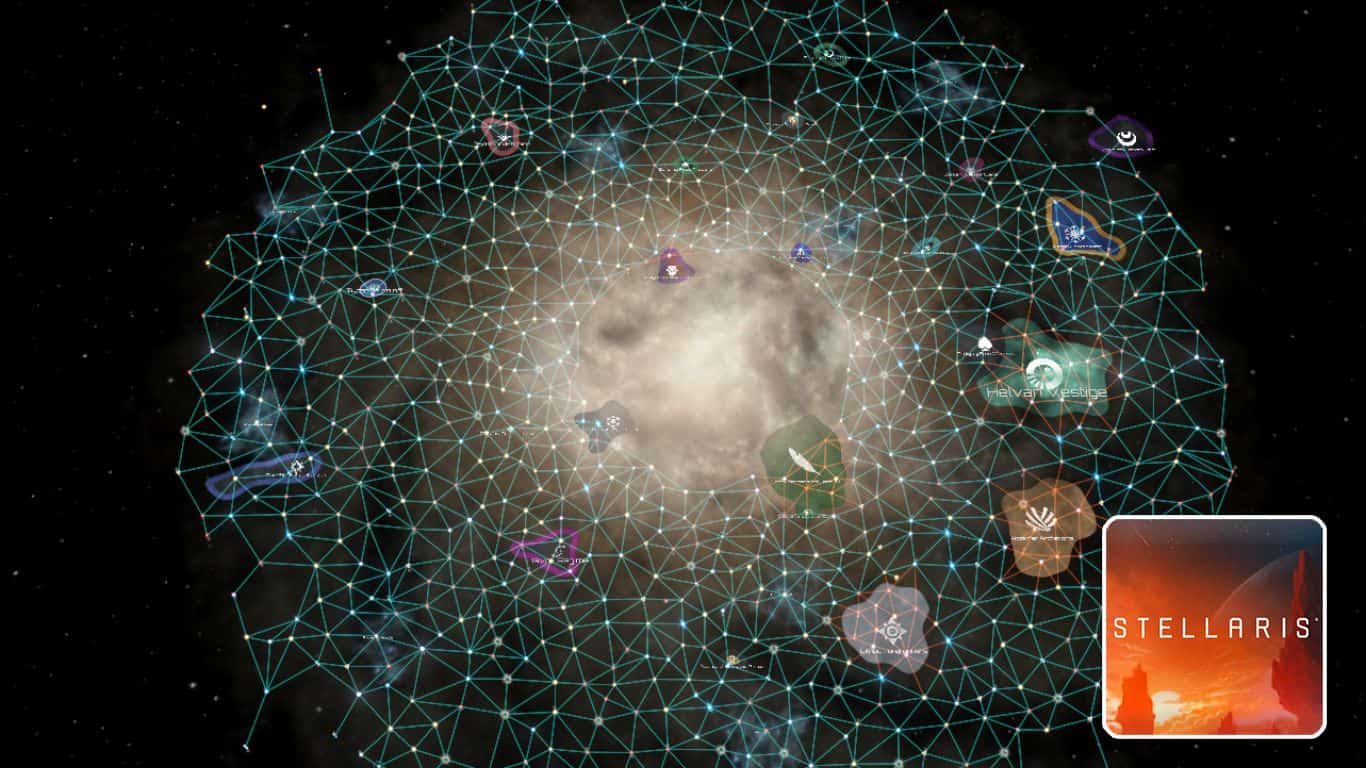There are a lot of things you can do to change up your next game of Stellaris. You could beef up the end-game crisis, play as a hive mind, not use slaves, or even set yourself a challenge to never start a war.
One of the easiest changes you can implement into your next game is changing the type of map you play in the game. The variety of maps available to players has grown a lot since the game was first released.
Recommended Read: Best Defense Platform Builds in Stellaris
This guide will cover all the different map shapes, the tactical implications of each map, and a couple of tips for each map.
No DLC is required for any of these maps, so even base-game enthusiasts can extract some good value out of this guide.
The best galaxy shapes in Stellaris, in our opinion, from worst to best, are ring, elliptical, spoked, cartwheel, starburst, barred spiral, and spiral. However, you should use the one that you prefer to play and that gives you the best gameplay experience.
Table of Contents
The Best Galaxy Shape in Stellaris
Whether you enjoy a map type in Stellaris or don’t is about as subjective an opinion as you can get. Some players may not care what map they play on, while others will fight tooth and nail to defend the honor of their preferred map type.
That is why we can’t tell you which map is the best in Stellaris and can only provide you with our own opinion on it. Whatever map you choose, the core gameplay of Stellaris will not change a bit.
Your job will still be to spread across the galaxy, meet aliens, and try to create the greatest star empire you can. Specific galaxy shapes will affect some micro-level tactical decisions, such as where you set up your choke points.
The next headings will provide some information about every map type. The order they are in is our own preference from “worst” to “best”.
None of the galaxy maps are a bad choice, and they are all great fun to play on, but if there must be an order, this is it.
Ring Galaxy Shape
First up on the list is the Ring Galaxy, which lives up to its name rather well. Most galaxies in Stellaris connect to a center point of mass; this is not the case here.
There is a gap between this mass and the hyperlane network that connects the stars.

This means if you want to get from one side of the galaxy to the other, your fleets must traverse the ring to reach the other side. This can make reacting to threats difficult, thus increasing the value of faster-than-light travel methods.
Problems can arise when neighbors begin shutting their borders to you; this has the potential to block your empire from the rest of the galaxy, resulting in a boring game for the player.
You can, of course, elect to bully your way out of that situation if your empire isn’t above a little violence.
There is no minimum galaxy size for this galaxy. Players who seek a much slower pace in their games should consider using a ring galaxy for their next play-through.
Elliptical Galaxy Shape
A much better name for this galaxy would have been spaghetti junction. In this galaxy, a mass of hyperlanes orbits the center with little to no gaps in the circle pattern itself.
Little pockets of stars spawn in clusters, often with multiple points of entry.
From a tactical sense, defending your empire’s borders in an elliptical galaxy is a logistical nightmare. Your enemies will be able to take their pick of attack routes on you, and you must be ever vigilant of potential threats.
Of course, that means these easy attack lanes are ripe for the picking for your own empire as well. Those who enjoy rapid attacks from multiple angles will be in heaven in an elliptical galaxy. Made even better by the fact that traversing the galaxy is a breeze.
There is no minimum galaxy size for elliptical galaxy shapes, and it shines more when used as either a tiny or huge empire size.
A tiny galaxy will provide a breakneck speed match, while a huge galaxy will provide a difficult tactical challenge for you to cut your teeth on.
Spoked Galaxy Shape
One of the stranger galaxy shapes we have access to in Stellaris is the spoked galaxy shape. Here, spokes of stars spread out from the galaxy center, like spokes on a wagon wheel.
There is no wheel on the outside of these spokes, thus forming tight avenues that empires must contend with.
Getting from spoke to spoke will often mean a trip to the center of the galaxy first, although sometimes a few hyperlanes may connect some spokes further out from the center.
It goes without saying that launching attacks at the farthest reaches of the spokes can be dangerous.

A great countermeasure to the spokes is the use of jump drive technology. This technology will allow your ships to hop the spokes without the need to travel along the hyperlane network.
Researching this technology early can be a great boon to your empire despite its dangerous nature.
Defending your empire in a spoked galaxy is a piece of cake if you get your positioning correct. If you spawn on the edge of one of the spokes, the defense of your empire is about as easy as it gets.
To play in one of these galaxies, your galaxy size will need to be set to medium as a minimum.
Cartwheel Galaxy Shape
I would forgive you if you looked at a cartwheel galaxy and a spiral galaxy and failed to see the difference between the two. The differences are subtle, but they do render them very distinct from each other.
Like a spiral, a cartwheel creates a circle pattern around the galaxy center. Where it differs is that the arms of the cartwheel are not separate from one another, making a complete circle pattern all around the galaxy.
This speeds up the pace of the game much in the same way an elliptical-shaped empire would. The clusters of star systems often spawn very close together, making the galaxy a tight contest for territory and resources.
There is no connection through the center of the galaxy either, making long trips a lot more dangerous for your empire.
The minimum galaxy size for this shape is medium.
Starburst Galaxy Shape
This galaxy shape is about as unique as it comes. For all intents and purposes, it is like a spiral galaxy, but with some of the spirals missing. The results are a galaxy of two halves.
One half of the galaxy tends to be dense and packed to the brim with systems and hyperlane networks. This half is where the majority of the action in the galaxy will take place.
The other half is far more sparse and less populated than the rest of the galaxy. There tends to be one route in and out of this section, making it easy to defend, but resources tend to be few and far between.
If you are on the farthest reaches of the starburst, you better hope you get along with your neighbors; otherwise, they can close their border off to you, neutering your expansion potential.
It will be tough to overcome this obstacle without access to jump drives or a gateway system.
The minimum galaxy size for a starburst galaxy is medium.
Barred Spiral Galaxy Shape
The barred spiral galaxy shape highlights how poor the names for the galaxy shapes are in Stellaris. If someone asked you to draw a barred spiral, would you know what shape that is? I know I wouldn’t.
The easiest way to describe it is as an “S” shape that is on its side. Think of it like a two-arm spiral galaxy, but rather than thin spirals spreading out from the center, the arms are much thicker.
As mentioned in the previous section, this galaxy also creates a galaxy of two halves. This time, the halves are equal.
Don’t be surprised if you see two factions originating from each spiral, and you can bet all your empire’s energy credits that they won’t like each other.
Getting around each half of the spiral tends to be an easy affair, as each spiral is jam-packed with star clusters and hyperlanes. Logistical difficulties tend to arise from transitions from one spiral to another.
Empires that call these transition routes home have a difficult choice to make. Do they try to play both sides and remain neutral to either spiral? Or do they pick a side to support and become the first line of defense against any would-be invasion?
There is no size restriction for a barred spiral galaxy.
Spiral Galaxy Shape
Last but not least is the big daddy of galaxy shapes, and the most customizable is the spiral galaxy. Fun fact: our own galaxy, the Milky Way, is a two-arm spiral galaxy.
Spiral galaxies have arms that originate from the center of the galaxy and expand out in a spiral pattern. The player gets to choose the number of arms at the beginning of the game, and this will dictate the minimum galaxy size.

Spiral galaxies tend to be the most well-balanced of all the galaxy shapes. The spirals often have hyperlanes connecting them throughout various pints of their arms. This negates the strength of funnels and choke points.
Seldom are players blocked from other parts of the galaxy, as there are often multiple routes to reach a particular destination.
Sensible space empire rulers often find a particular cluster of stars and attempt to claim them all. Once all entry points to that cluster are under control, defenses are set accordingly to make it difficult for the enemy to get in.
A two-arm spiral has no size restrictions. A three-arm spiral must be at least small. A four-arm spiral has a minimum size of medium. And a six-arm spiral must be large.
This is everything you need to know about the best galaxy shape in Stellaris.
If you have any questions or suggestions for this guide, please let us know in the comments section below. As always, have fun deciding which galaxy shape is best for you in Stellaris.




